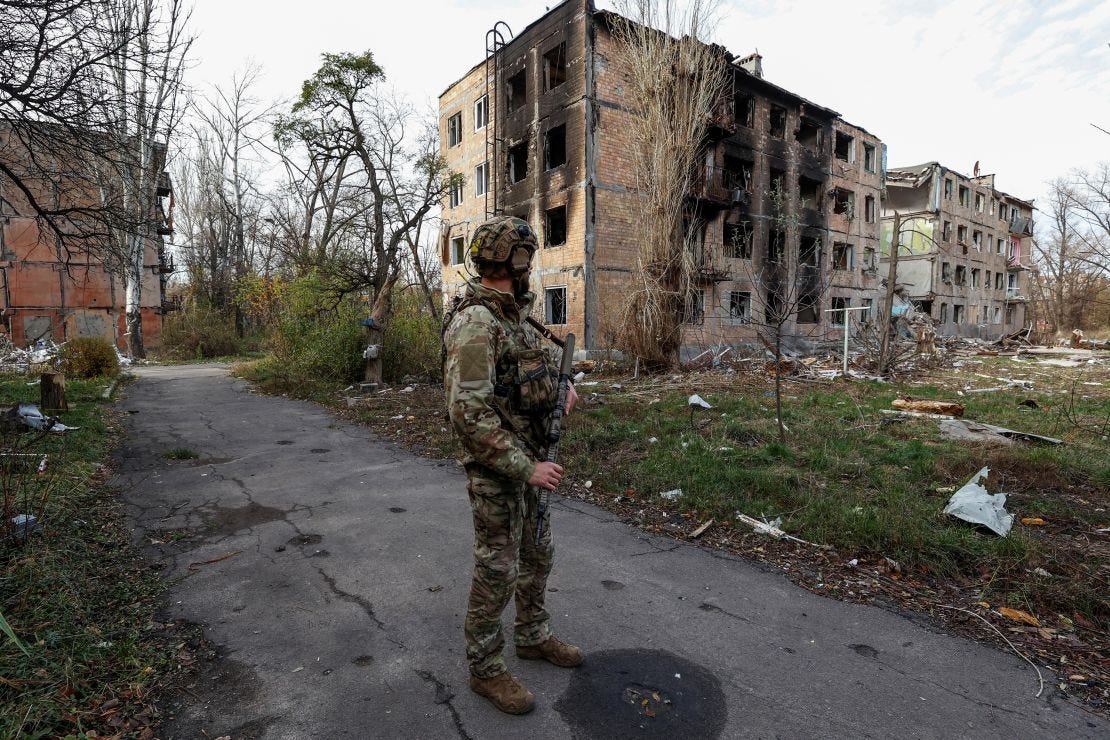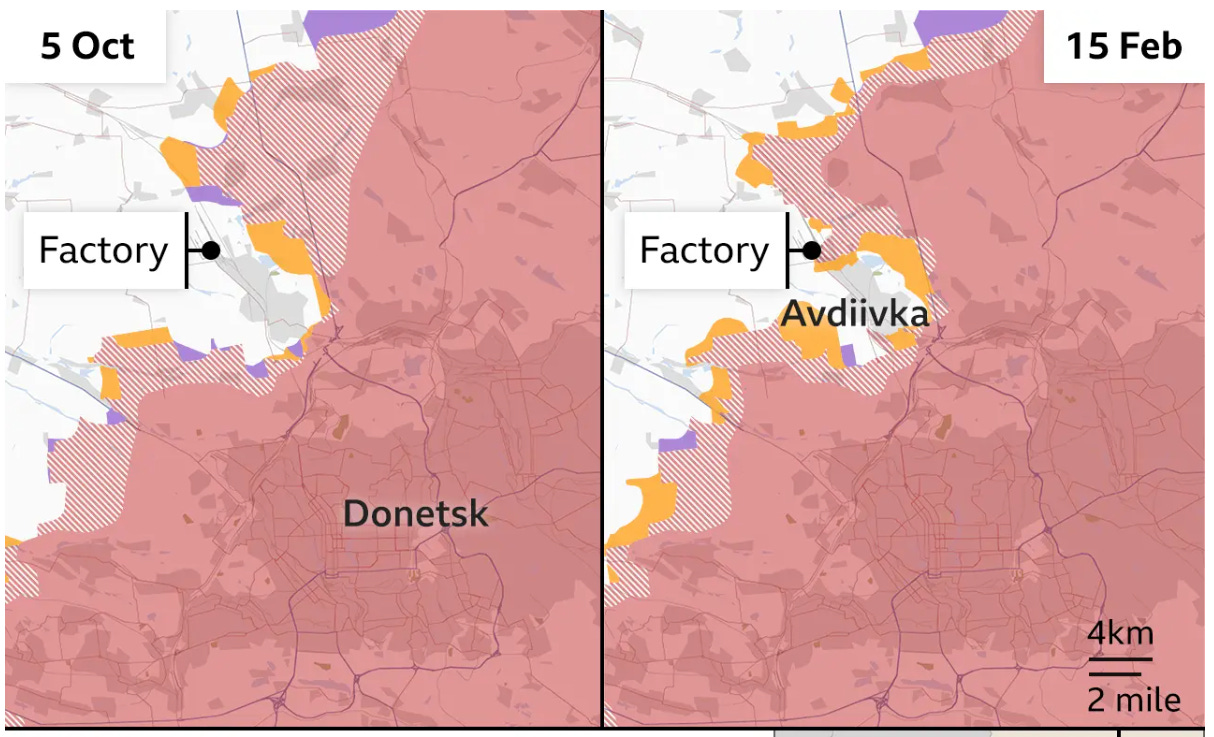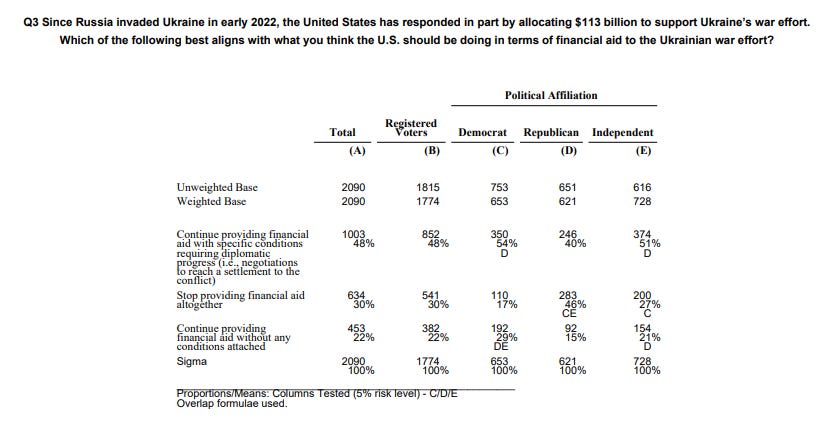The loss of another smoking Donetsk rubble heap with zero productive capacity is less impactful than the increased aid from Europe - and, many believe, eventually from embarrassed Republicans - the US that now seems likely to come. JL
Phillips O'Brien reports in his substack:
Even with the Ukrainian withdrawal, the Russian advance has been about 5 miles, and at the cost of massive equipment losses and casualties. Up until this point its been a battle worth fighting for Ukraine. But it had to stop this slaughter of Russian forces due to shortages, in particular, of artillery ammunition which had been much of US aid, that made holding the town too costly. Ukraine is trying to preserve its soldiers lives, and can only risk them if they take a greater toll on the enemy. With ammunition running low, that risk of Ukrainian losses without much larger Russian losses, was too high. What happens next will not involve a vehicle-led breakout. The reality is that Russian advances are being done at the pace a human can walk. As the Ukrainians dig in, the line stabilizesSo, I thought I would try to provide a summary of where things stand after the Ukrainian withdrawal, then look a little at the US, public opinion and the ongoing debate over US aid for Ukraine.
Avdiivka—this is what happens when your main partner stops supporting you
On Saturday morning there were stories everywhere that the Ukrainians were pulling forces out of Avdiivka. Eventually, Ukrainian command released a statement to the effect that Ukrainian forces were being withdrawn—confirmation that the battle was over. The Deep State Map has now moved its front line to the west of the town—putting all of central Avdiivka under Russian control.
The Ukrainians had held the town against continual Russian attacks for more than 4 months. This present battle started in early October (though Avdiivka had been a front line town in the war for 9 years. To show you how little Russian advances has been, the BBC put up this useful map.
Even with the Ukrainian withdrawal, the Russian advance so far has been about 5 miles in length, and at the cost of massive equipment losses and casualties. In December, two months after the offensive started, US intelligence (which is normally cautious about listing Russian losses) released these estimates.
“Since launching its offensive in October, we assess that the Russian military has suffered more than 13,000 casualties along the Avdiivka-Novopavlivka axis and over 220 combat vehicle losses-the equivalent of 6 maneuver battalions in equipment alone.
Why Ukraine had to stop this slaughter of Russian forces seems pretty clear from what is being said in Ukraine. Shortages of equipment, in particular vital artillery ammunition which had been much of US aid, made holding the town too potentially costly. Ukraine is trying hard to preserve its soldiers lives, and can only risk them if they have a far greater chance of taking a toll on the enemy. With ammunition running low, that risk of significant Ukrainian losses without much larger Russian losses, was too high.
Remember that when those who are sabotaging the continuation of aid to Ukraine claim that they are doing it out of compassion for Ukrainian losses.
Up until this point its been a battle worth fighting for Ukraine. The Russians for political reasons seemed willing to expend whatever the could to take a town of no strategic value. Practically no one was left living there and Avdiivka provided no resources to the Ukrainian war machine. Had Ukraine the ammunition, they would have tried to stay at least until the Russian elections (Putin seems desperate to have some “victory” before the vote, and Avdiivka was one of his primary objectives).
What happens next will almost certainly not involve a fast vehicle-led breakout. The reality is that Russian advances are still being done at the pace a human can walk/run not at the pace a vehicle can drive. If the Ukrainians can dig in, create their own defensive line, and have at least some ammunition, the line will stabilize soon. The real crunch is still to come.
Of course had Ukraine been aided properly, even this withdrawal would not have had to happened.
US Public Support Remains Strong—Even a Poll Designed to Find the Opposite could not.
Speaker Johnson took the cowardly way out of the impasse in Congress and adjourned the House early without allowing for a vote on the Ukraine aid package (part of the deal approved by the Senate). That means everything is on the shelf until the end of the month at the earliest. I thought then I might engage with one of the most remarkable polls I’ve seen recently. One that had results obviously much different than its sponsors wanted—though that did not stop them from spinning it desperately.
To much fanfare the Quincy Institute released its latest poll on US public opinion and Ukraine. The headline that they chose made it sound like the US public was souring on aiding Ukraine.
New poll: Nearly 70% of Americans want talks to end war in Ukraine
Wow, you might say, that means Americans are tiring in their support of Ukraine. That certainly would be what the Quincy Institute would want you to believe. They have published the same story regularly during the war. Here are two Quincy headlines from earlier in 2023.
Poll: Public support for sending military assistance to Ukraine slips
Is weakening support for Ukraine war following a historical pattern?
You see the pattern. Quincy has also argued continually against US aid for Ukraine. So they have a particular outlook which they desperately seem to want to find, regardless of what their poll actually says.
Actually, even with their headline, and some of the most leading questions I’ve seen in a poll about US public opinion, what emerges from the poll is how strong US support for Ukraine still is.
First off—Americans remain very engaged with the war and view it as important. The opening question makes that clear—about three-quarters of Americans are concerned with what is happening because of the Russian invasion.
The next question shows that not only are Americans concerned—they don’t expect this war to be over soon. A whopping 84% of Americans expect the war to last at least two more years. So they are both deeply concerned with the war and expect it to continue for a while.
The next question, however, really shows how this poll has let down the people who constructed it to get a specific answer. The question asked was this:
Q3 Since Russia invaded Ukraine in early 2022, the United States has responded in part by allocating $113 billion to support Ukraine’s war effort. Table 7 Which of the following best aligns with what you think the U.S. should be doing in terms of financial aid to the Ukrainian war effort?
The question is geared to make the person answering say: “Boy, the US has sent so much money to Ukraine—its probably time to stop it.” By making it sound like the US has allocated Ukraine $113 billion, the poll-makers are putting into the person’s mind that this is all terribly expensive. They conveniently leave out that the vast majority of this money has been spent employing Americans to make goods in the USA—it hasnt gone to Ukraine at all. Basically the US has handed Ukraine old military equipment, and then employed Americans with the money allocated to build brand-spanking new equipment for US forces. In other words its been money spent employing Americans and giving the US military better, newer equipment.
However, having asked a leading question, the poll-makers got a result that they must have found to be terribly perplexing. 70% of Americans still wanted to continue aid for Ukraine (48% of whom also agreed to a meaningless undefined qualifications on wanting negotiations). The really depressing thing for Quincy must have been that only 30% of Americans were in favor of halting aid to Ukraine now.
To show how meaningless that negotiations qualifications statement was, a few questions later, the poll comes out with a resounding majority against the Biden Administration stepping up its diplomatic interventions to end the war. Only 29% of Americans want the administration to do more diplomatically to help end the war..
So overall, this poll shows a very strong level of support for US aid to Ukraine.
A large majority of Americans are following the war with concern,
A large majority believe it will last for years longer.
A large majority want the US to continue aiding Ukraine
A large majority dont want the Biden administration to do more trying to diplomatically end the war.
Considering that the poll had been constructed to find something very different, its a great sign that US popular support for Ukraine remains high.
In other words, the reluctance of Republicans in the House to support Ukrainian aid so far is not down to public pressure (other polls also show US support for Ukraine is high). The reluctance is down to a fear of Trump. A majority of Americans in the public and Congress support the aid—just Trump and his Trumpolytes are desperate to stop it.
Have a rage-filled rest of the weekend.


























1 comments:
"JL's analysis hits the mark, highlighting the true cause behind the withdrawal. Republicans' refusal to aid Ukraine due to Putin ties or fear of losing Trump's support is clear. With Europe and potentially embarrassed Republicans stepping up, the impact of losing Donetsk diminishes against increased aid prospects."
Mutual Protection Orders in New Jersey
new york uncontested divorce instructions
Post a Comment